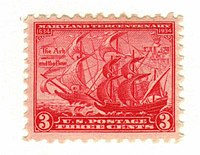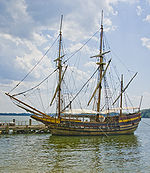 The Ark and the Dove, on a 1934 U.S. commemorative postage stamp.
| |
| History | |
|---|---|
| Name | The Ark |
| Owner | Hired by Cecilius Calvert, second Baron or Lord Baltimore, (1605–1675) |
| Launched | c. 1630 |
| Fate | Lost 1635 |
| General characteristics | |
| Tons burthen | 400 |
| Length | Approximately 132 feet (40 m) on deck[1] |
| Beam | 32 feet (9.8 m) |
| Draft | 14–15 feet (4.3–4.6 m) |
| Depth of hold | 14 feet (4.3 m) |
| Propulsion | Sail |
| Sail plan | Three masted, Spritsail& spritsail topsail, fore course, fore topsail & fore topgallant, main course, main topsail and main topgallant, Lateen mizzen with square topsail. |
| Complement | Approximately 40 seamen |
| Armament | Unknown, but probably capable of mounting 20-25 cannon. |

The Ark was a 400-ton English merchant ship hired in 1633 by Cecil Calvert, 2nd Baron Baltimore to bring roughly 140 English colonists and their equipment and supplies to the new colony and Province of Maryland, one of the original Thirteen Colonies of British North America on the Atlantic Ocean eastern seaboard. On the historic trans-oceanic voyage from England in late 1633 and early 1634, The Ark was accompanied by the smaller 40-ton pinnace Dove.[citation needed]
- ^ Ship characteristics derived from plans drawn using 17th Century techniques.